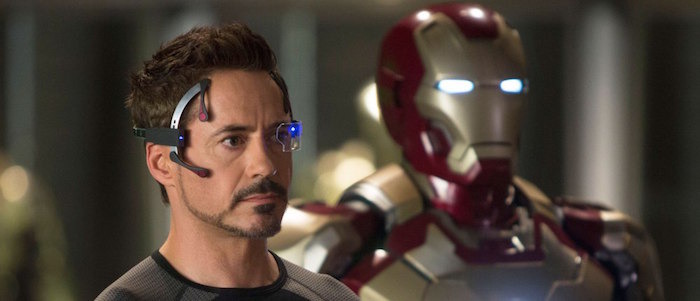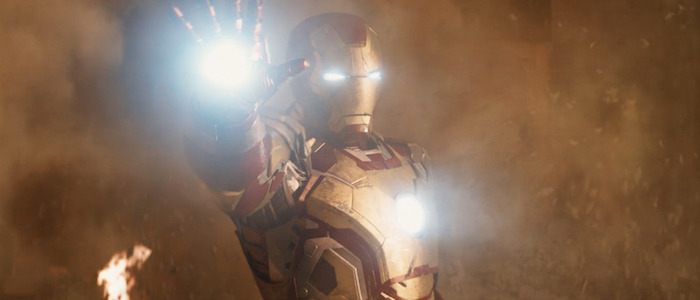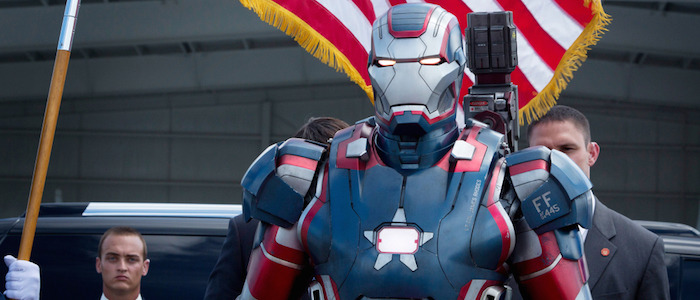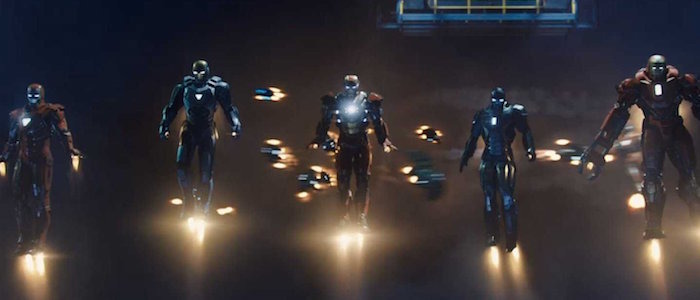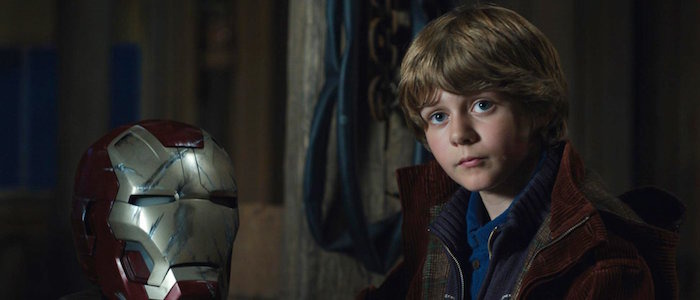'Iron Man 3' Proved That Marvel Works, Even When It Doesn't
(Welcome to Road to Infinity War, a new series where we revisit the first 18 movies of the Marvel Cinematic Universe and ask "How did we get here?" In this edition: Iron Man 3 brings a personal new style to the MCU, even as it stumbles in the homestretch.)
Marvel needed to prove exactly one thing after The Avengers, and that was the possibility of different kinds of stories. While Guardians of the Galaxy would go on to be the biggest post-Avengers ("Phase 2") departure, it was Tony Stark's first solo adventure after the Battle of New York that answered the question on everyone's mind: "What comes next?" Would Marvel be able to come close to rivalling its superhero team-up spectacle?
Well, no. It most certainly wouldn't, but it also didn't have to. Iron Man 3 is nothing like its crossover predecessor. In fact, it barely has anything in common with Jon Favreau's Iron Man and Iron Man 2, but what it does have, despite featuring another vaguely defined character arc, is a unique sense of identity.
Black to Basics
Despite the studio notes it adheres to, like having to swap out its female villain for a male one for reasons of toy sales, Iron Man 3 is a Shane Black film through-and-through. The writer-director's creative DNA, which he's been injecting into other people's stories as early as 1987's Lethal Weapon, is baked into the fabric of this Marvel threequel.
Outside the odd Dutch tilt in Thor and the self-contained silent drama in The Incredible Hulk, Captain America: The First Avenger was perhaps the only "Phase 1" film that stepped outside the superhero cookie cutter, visually speaking. You can thank Joe Johnston of The Rocketeer for that, but not every Marvel movie can fit the mold of an old-world period adventure. Even The Avengers, which delivered some of the finest superhero spectacle till date, didn't kick into high gear in terms of visual storytelling until in the final battle, in which the major beats work because they translate character into action. For instance, the fluid long-take where The Avengers fight in tandem for the very first time, with each Avenger getting their moment to shine. The only other sequence where you can feel what's going on without needing to be told by the characters was cut from the movie. For the most part, these films rely on straightforward dialogue to deliver emotional information. Which isn't to call their directors' talent into question – Kenneth Branagh is a Shakespeare virtuoso, and Joss Whedon proved his dramatic prowess in Avengers: Age of Ultron – but Iron Man 3 feels like the first time someone was handed one of these and allowed to let loose.
Iron Man 3's distinct tonal consistency is also a function of the story it tells. Shane Black's penchant for the Christmas setting seen throughout his filmography is because he feels the holiday "represents a little stutter in the march of days, a hush in which we have a chance to assess and retrospect our lives." In the case of Tony Stark, Christmas Eve comes about with him isolated in a remote Tennessee locale. He's far flung from Happy and Pepper, the loved ones he put in harm's way, and he has to figure his way out of this situation without the help of his suits. The stage is set for Stark to reflect on his decisions, and on his post-Avengers identity as it relates to his Iron Man persona. And while the film doesn't quite follow through on these threads as well as it ought to, it's in the visual articulations of these themes that the film finds its momentum.
Shane Black, along with cinematographer John Toll (The Thin Red Line, Cloud Atlas) departs from the bright palette of The Avengers and delivers a far darker entry, visually and emotionally. The entire film feels frigid even before Stark gets stuck in the snow, with cold lighting defining the lighting of every space, the muted tones of its set design interrupted only by deep red explosions. It's drab without being dour, with the characters seemingly having to fight their way out of shadows, as the camera observes rather than empathizing.
This observational quality is by design. Even as we see Pepper's meeting with Aldrich Killian (Guy Pearce) through Happy's eyes, he relays this information to Tony over the phone, at a significant distance. It's as if Black is people-watching, and Tony is unable to connect. Crowds move through space and the frame itself moves through crowds as they investigate (or try to take advantage of, in the case of the media) the terror attack on Tony's home. Tony, of course, is forcefully removed from his own narrative by this point, having been launched thousands of miles away. Physically, and emotionally, he could not be more distant.
Combined with the fluidity of both Black's action as well as his dialogue (from a script co-written by Drew Pearce), Iron Man 3 bleeds a distinctly "cinematic" texture, with Robert Downey Jr. bringing the whole thing home with his dry wit as usual. But where the film does manage to extend beyond an exercise in observation – a necessary exercise so Iron Man can define himself in relation to other people – just so happens to be in the moments that are at once most potent, and most readily dropped: Tony Stark's PTSD.
Nothing’s Been The Same Since New York
Shane Black was instrumental in Robert Downey Jr.'s comeback from his drug issues, with 2005's Kiss Kiss Bang Bang. His past also had a hand in him being cast as Tony Stark; Iron Man was once known as Marvel Comics' alcoholic superhero – 1979's Demon in a Bottle was perhaps his most instrumental story arc. And while the character's alcoholism never comes up in these movies, his addictions and obsessions come in forms that feel woven into the fabric of this universe. In this case, an addiction to building armour, exacerbated by his trauma.
Clinical psychologist Dr. Andrea Letamendi argues that Tony Stark's symptoms in this film could, in fact, be interpreted as Post Traumatic Stress Disorder. It's worth noting however, that she rightly offers no absolutes, stressing on just how much such diagnoses depend on the specifics of how one interprets trauma. Tony seems to display three key factors for diagnosis, from avoidance of potential trauma triggers which lead to his anxiety, to hyper-arousal (he's been awake for 72 hours when we meet him in this film) to vivid recollection, via dreams and visions. More importantly, he meets the criteria of functional impairment with regards to his personal relationships, and Tony Stark is above all else, more vulnerable to PTSD than the average human being, owing to what Letamendi calls "re-deployment."
Tony Stark has been experiencing trauma since the very first scene in Iron Man, whether it's being bombed, having shrapnel lodged in his chest, or being kidnapped and tortured, and he's been embroiled in violent conflict ever since. Thus, the Iron Man armours are as much an addiction as they are a symptom, like PTSD-afflicted soldiers sleeping with guns by their bedside (Tony calls to one of his armours in his sleep). There are now 42 versions of the Iron Man armour, each prepared for dozens of different contingencies, and the 42nd has even begun to replace Tony physically in his interactions with Pepper, as he operates it remotely from his workspace. Tony is frozen in the moment he went through the wormhole above New York City, and his symptoms are visualized kinetically. The creeping camera is traded in for quick zooms and uncomfortable close ups, a rapid visual shift that feels inescapable to the character.
The constant callbacks to the wormhole event as simply "New York" and Tony's vengeful, self-destructive attitude towards vaguely Middle Eastern terrorist The Mandarin (Ben Kingsley) call to mind America's own post-9/11 political tenor (to no real end, despite the potential for exploring wartime paranoia). However, it's the need to move past the events of The Avengers that makes Iron Man 3 a particularly interesting sequel in the shared-universe context. As much as the film is about defining Iron Man outside of his suits, it's also about beginning to define this larger narrative world outside its own most recognizable moment, going as far as to introduce antagonists independent of the previous films and their inevitable fallout.
The Extremis Soldiers simply exist, with no connections to Gamma Radiation or the Super Soldier Serum, and Killian had been on this path for a decade before The Avengers. It's as if Stark has to move past the memory of his major crossover, toward something entirely new, just to make this movie happen. However, that meta-narrative seems to take far more precedence than Tony's actual state of mind, a story thread that's set up amply throughout the film's first two thirds and then promptly forgotten.
Tony is in a bad way. He can't sleep, owing to the wormhole nightmares. His anxiety is first triggered by a children's drawing of him flying towards the source of his trauma, which leads to a public breakdown. He's triggered by young Harley Keener (Ty Simpkins) simply mentioning New York, and it even gets to a point where he has a mid-freeway episode for almost no reason at all, which he combats by building new weapons out of hardware scraps while his suit is out of commission. Building weaponry is still his crutch at this point, but it's also the last time his anxiety or potential PTSD come up in the narrative.
What follows is certainly a passable display of the film trying to figure out who Tony is outside the suit. Fighting with only one Iron Man boot and glove is a hilarious action scene, but the film's entire climax is muddled in almost every way, including and especially how it tries to define Tony Stark in relation to his new villain. Like Thor before it, it's another example of a film being "almost there" when it comes to telling a coherent, character-driven story, but it's misaligned in ways that feel uncanny. Which is a shame, because Iron Man 3 is loaded with potential.
A Clash of Ideologies, or Lack Thereof
There's much debate as to the movie version of The Mandarin, originally an orientalist caricature best left in the '60s. While the character being cast part-Indian rather than Chinese brings up a complicated aspect of the debate on Hollywood's Asian erasure, the presumable avoidance of an offensive Chinese villain for the purposes of China's box office was inadvertently sound, from an artistic standpoint. There's too much racial baggage for The Mandarin to be carried forward as mystic figure or anything resembling his original iteration, and so the form he initially takes here – a bastardization of ideas and iconographies – finds itself at an interesting nexus. On one hand, much like ISIS, he lays claim to terrorist attacks that probably aren't his own, likening the explosion at Hollywood's Chinese Theatre to the American-in-origin fortune cookie, a manipulation of Eastern imagery and ideology mass-marketed to the west. On the other, this is exactly who The Mandarin is as well.
As revealed in a twist late into the film, The Mandarin is a hodgepodge of ideas, strung together by a clueless actor (Kingsley's Trevor Slattery, a comedic revelation). He borrows the symbol of The Ten Rings, the organization that kidnapped Tony Stark in the first film, and he fashions himself – or rather, is fashioned by Aldrich Killian – as a moralistic zealot, hell-bent on attacking America and its interests, as if unintentionally tapping in to Marvel's own political hesitance thus far. The distinctly vague appearance of "the war on terror" is exactly the point, allowing Killian to sell biological weapons to both sides, even though these "both sides" aren't quite articulated either. Whether Disney, or Killian's Advanced Idea Mechanics, political specifics don't matter so long as the product sells.
Iron Man 3 features a marginally more hard-hitting critique of American military industrial complex than Iron Man, owing to its exposure of the sheer lack of defining ideology behind it. Militarism is sold and packaged through media narratives on multiple fronts; one on hand, it portrays ruthless foreign threats whose outlook is irrelevant so long as it sounds scary to Americans. On the other, the film shows America's limp, lip-service-only ideological response, painting over James Rhodes' (Don Cheadle) heavily armed "War Machine" in red, white & blue and calling it "The Iron Patriot," as if its unsanctioned foreign interventions become acceptable as soon as they're given a nationalistic paintjob.
And while the film does little to portray the actual effects of this warmongering (granted, the interventions themselves are painted with a brush of dark comedy), it does portray the American response as predictable and ill-considered, with Killian conning the American president into invading Pakistan on two different occasions as he sets his traps elsewhere. Compared to its predecessors, which put the blame of military industrialism solely on industry, Iron Man 3 draws a line straight to the U.S. Commander-In-Chief.
The downside to this lack of ideology, however, is how Tony Stark's journey fails to be a proper foil to it; to combat a villain fighting for nothing, you have to fight for everything. Killian, whose motivations are disconnected from Tony's "self-created demons" despite showing up in the opening prologue, has a ruthless, unfeeling dedication to military capitalism. This dedication is on full display after the Mandarin reveal; he treats his soldiers as disposable, and he readily shoots and kills Maya Hansen (Rebecca Hall), the one person whose goals and methods could be aligned with his own. He doesn't care about the people closest to him, which is what separates him from Tony Stark, whose arc involves learning that Happy, Pepper and the likes ought to be more important to him than his numerous suits. This part of his journey is externalized deftly when Pepper seemingly dies, followed by Tony's far-too-late realization of just how good he actually had it. But it's a moment that remains entirely disconnected from both the forgotten PTSD narrative as well as the actual form taken by the climax.
Fireworks in Lieu of Character
Having Tony and (to an extent) Rhodey shed their armour for the final battle makes sense. The Iron Man has become a crutch, and both War Machine/Iron Patriot and The Mandarin have proven the emptiness of political theatricality for the manipulation of sentiment; The Mandarin eventually co-opts the Patriot armour as well. Who are these people when their facades are stripped away? The Mandarin is the fire-breathing monster Aldrich Killian, a man with no care for humanity despite the life-improving potential of his experiments. Rhodey is, well, Rhodey. This narrative was never about him, but it stands to reason that Tony should be put to the ultimate test here. And yet, despite not wearing his suits at first, he ends up relying on them entirely.
Tony summoning dozens of Iron Man suits is cool. Each one having a different design and purpose is cool, despite primarily existing to sell toys. The remote centralization of these unmanned drones is, err, dangerous, but it looks cool and is expanded upon in future installments. The image of Tony jumping from suit to suit is cool, and the empty suits fighting anonymous henchmen, while the definition of empty spectacle, is still pretty cool. It's all genuinely cool to look at, as any superhero climax ought to be, but it's also entirely at odds with Tony's journey throughout the film.
His reliance on his technology is never put to the test. If anything, the finale supports his obsessions. Even his eventual "Clean Slate Protocol," wherein he destroys all his suits for Pepper's sake, isn't arrived at through narrative steps that feel logically or emotionally sound. The realization of Pepper's importance to Tony works in and of itself. This is the first film in which their relationship feels substantial, but the disconnect arrives when it comes to what the suits represent for Tony and his state of mind independent of Pepper. How Tony Stark defines himself in relation to other people comes at the cost of defining Tony Stark himself.
Pepper is certainly affected negatively by Tony's actions and by his PTSD, and overcoming his selfishness precedes the "Clean Slate" protocol, but his suffering from PTSD and/or anxiety is not in itself an act of selfishness – or an intentional act at all. Which isn't to say the film is conflating the two, but Tony's reliance on this new addiction is just as much a psychological phenomenon as it is a dramatic want or desire. The destruction of his outlet (or symptom) doesn't help him confront its root cause. This root cause forms so much of the backbone of the film's first half that forgetting about it midway feels disingenuous to story being told.
The Road Ahead
In the film's closing narration (another Shane Black flourish), Tony says both "I'm a changed man" and "I am Iron Man,"a callback to the end of the first film. But these sentiments feel distinctly at odds with one another. Tony hasn't given up being Iron Man – the removal of his arc reactor merely indicates no longer relying on his armour – but the change in question doesn't come from a place of no longer needing his suits. It comes from wanting to no longer need them. Which is far from the same thing – the recognition that change can or should happen is different from actual change – and it's an unsatisfying narrative conclusion in a story about the personal and interpersonal effects of trauma. But, like its predecessors, the film also sets into motion specific narrative faults that are eventually taken advantage of, in ways that change the series' approach to Tony Stark.
By this point in the franchise, Robert Downey Jr. was Marvel's not-so-secret weapon, and Iron Man 3 features some of the best dramatic work of his career. He's allowed to dig deep into what makes this character tick (and what prevents him from ticking), working in tandem with Black's signature combination of sarcasm-as-shield contrasted with unshielded moments of vulnerability. Even when the spinning plates prove to be too many to make sense of, Downey Jr. balances them with finesse, which is part of why this film looks and feels as coherent as it does, despite its major thematic disconnects.
It's like the reset button was pushed on Iron Man once again, taking him a step back (or at best sideways) with mistakes unconfronted and only the appearance of headway. But it's this inadvertent characterization of Tony Stark as an intertextual embodiment of repetition, with a penchant for combating mistakes with more mistakes, that would form the backbone of the Iron Man narrative going forward. In Avengers: Age of Ultron, in Captain America: Civil War, even in Spider-Man: Homecoming, cementing him as one of the most interesting characters in all of popular culture.
Even when Marvel messes up, they make up for it – assuming you even noticed they messed up in the first place.

